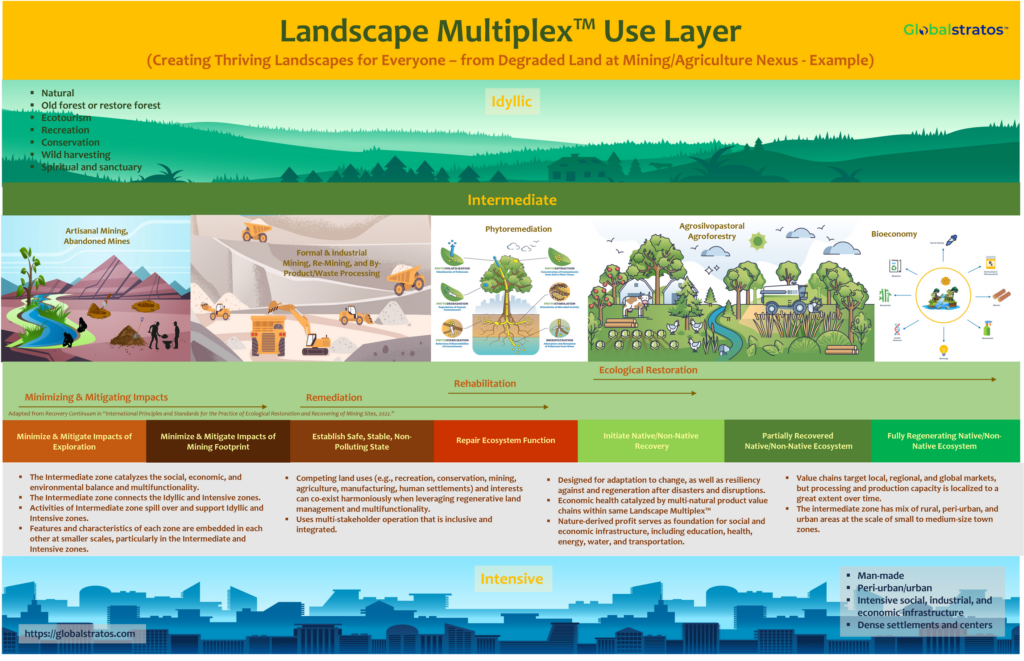
A Landscape Multiplex™ is a shalom structure (a strategic and operational level structure) developed to derive systems of prosperity and causes interactions between social and ecological components such as human settlements, topography, multiple land uses, natural resources, and climate. A landscape approach is an integrated management practice that combines all aspects of a landscape into a single management system. A landscape at the right scale, allowing for multifunctional land uses, and with a landscape approach mak,es room for different, and even conflicting or competing, interests and uses of stakeholders of a landscape.
The common vision of Landscape Multiplexes™ is “creating and sustaining thriving landscapes that are resilient, restorative, and regenerative quality places.”
We design and analyze a Landscape Multiplex™, according to five dimensions:
1) the structure of the landscape – its whole, parts, their interconnections and interaction,
2) the function of the landscape – what does it do?,
3) the goods and services the landscape produces,
4) the benefits humans get from the landscape, and
5) the value, measured quantitatively and qualitatively, of the benefits humans receive, directly and indirectly from each of the preceding dimensions.
The structure of a Landscape Multiplex™ has four primary layers, each having its own sublayers as outlined below:
| Primary Layer | Sub-Layer | Definition and/or Functions |
| Placemaking | Placemaking | Placemaking is the process of creating quality places that people want to live, work, play, and learn in. Its aspects include: Capture, embed, and vitalize the spirit, essence, and values of people and place. (Anchor) Strengthen quality of place Seize green/blue opportunities. Optimize infrastructure investment. Enhance transportation connections. Build innovation, creativity, arts, and culture. Use tactical activities for civic engagement. Be pedestrian-oriented. Develop mixed-use properties and facilities. Design and develop for human scale form. Produce places that are safe, comfortable, sociable, and green. Provide lots of choices in recreating, housing, transportation, and entertainment. Respect historic structures and culture. |
| Community Development | Community development is the ongoing, continuous process of development within a geographic or social community. The elements of a geo-anchored community includes, but is not limited to: Empower people to make change. (anchor) Provide human services. Expand socioeconomic opportunities. Implement neighborhood conservation, creation, and rehabilitation. Conduct targeted development/redevelopment. | |
| Economic Development | Economic development is the engine to catalyze the economic and financial resources to support the entire landscape. The elements of economic development include, but are not limited to: Generate economic output to support quality places and people. (anchor) Promote advancing innovation and technology. Conduct marketing and promotion. Attract capital. Diversify business base. Create global connections. Attract and retain business. Provide entrepreneurial support and services. Drive workforce development. Attract and retain talent. | |
| Infrastructure | Infrastructure to develop and maintain are: Infrastructure that technically makes quality places work. (anchor) Roads Transit Sewer Water Stormwater management Garbage collection Recycling, re-furbishing, and re-using Street lights Schools Police Fire Gas, electric and other utilities Health facilities | |
| Landscape Functions/Uses and Boundaries | Idyllic | Focused on nature. Some of the functions are: Maintain natural balance. Provide recreation and ecotourism. |
| Intermediate – Rural | Develop and operate regenerative extractive rural industry, e.g., mining, agriculture, forestry, fisheries, and aquaculture. Develop and operate other extractive industries or businesses, but in balance with regenerative ones. | |
| Intermediate – Suburban | Develop and operate living, play, and learning facilities near work.Develop and operate supporting sector businesses and facilities. | |
| Intensive | Develop, operate, and maintain urban centers for a variety of purposes. | |
| Landscape Self-Sustenance and Healing | Self-Sustenance | A landscape remains in a state of health and integrity. |
| Adaptation | A landscape is able to adapt to changes in its environment while maintaining its health. | |
| Resilience | A landscape can resist or bounce back to its health and integrity after shocks, disturbances, or perturbations. | |
| Restoration | A landscape that is not resilience or adaptive enough has the capacity to enter a healing process to restore it to its healthy and integral state. | |
| Regeneration | When a landscape cannot continue to exist as it has, it emerges in a new form or another one takes its place. | |
| Landscape Element Scales | Geo-Bio Units: Plant/Animal Field/Plot Farm/Site Group of Sites Ecosystem Landscape (Cluster) Biome Global | Biophysical functions at the level of geo-bio unit. |
| People Units: Individual Family/Household Neighborhood/Village Inter/Intra/Cross-Group Municipality State/Province/Region National Global | Human and social functions at the level of the people unit. |
